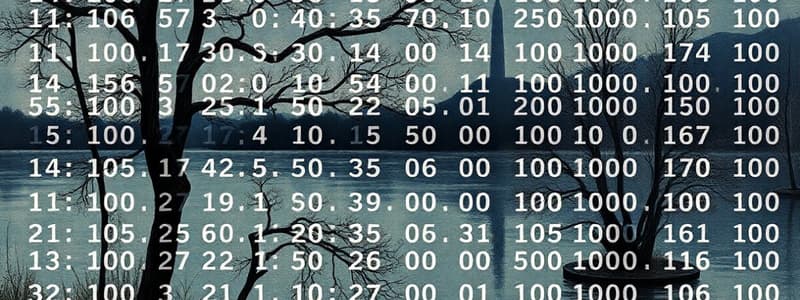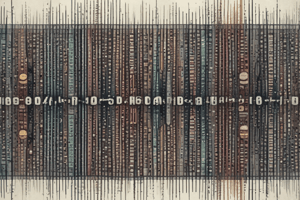Podcast
Questions and Answers
Which number system uses only two digits?
Which number system uses only two digits?
- Decimal
- Octal
- Binary (correct)
- Hexadecimal
What is the binary equivalent of the decimal number 13?
What is the binary equivalent of the decimal number 13?
- 1101 (correct)
- 1110
- 1011
- 1001
In binary to decimal conversion, what is the decimal value of the binary number 1101?
In binary to decimal conversion, what is the decimal value of the binary number 1101?
- 12
- 15
- 13 (correct)
- 14
How is hexadecimal used in relation to binary numbers?
How is hexadecimal used in relation to binary numbers?
Which digit in hexadecimal corresponds to the decimal value 14?
Which digit in hexadecimal corresponds to the decimal value 14?
What is the octal representation of the binary number 100 101 111?
What is the octal representation of the binary number 100 101 111?
Which of the following statements about number representation in computers is false?
Which of the following statements about number representation in computers is false?
When repeatedly dividing a decimal number by 2 for conversion to binary, what do the remainders represent?
When repeatedly dividing a decimal number by 2 for conversion to binary, what do the remainders represent?
What is the main advantage of using two's complement representation for negative numbers?
What is the main advantage of using two's complement representation for negative numbers?
What happens during an overflow condition in computers?
What happens during an overflow condition in computers?
In the context of floating-point representation, what is one of the main limitations?
In the context of floating-point representation, what is one of the main limitations?
What is the impact of the number of bits used in signed number representation?
What is the impact of the number of bits used in signed number representation?
What type of numbers is floating-point representation specifically designed to accommodate?
What type of numbers is floating-point representation specifically designed to accommodate?
Flashcards
Overflow
Overflow
Occurs when a number exceeds the storage capacity during calculations.
Underflow
Underflow
Occurs when a number is below the minimum value that can be represented.
Two's Complement
Two's Complement
A method for representing signed integers, simplifies binary arithmetic.
Floating-Point Representation
Floating-Point Representation
Signup and view all the flashcards
Round-off Errors
Round-off Errors
Signup and view all the flashcards
Binary Number System
Binary Number System
Signup and view all the flashcards
Decimal to Binary Conversion
Decimal to Binary Conversion
Signup and view all the flashcards
Binary to Decimal Conversion
Binary to Decimal Conversion
Signup and view all the flashcards
Hexadecimal System
Hexadecimal System
Signup and view all the flashcards
Octal Number System
Octal Number System
Signup and view all the flashcards
Computer Representation of Numbers
Computer Representation of Numbers
Signup and view all the flashcards
Conversion Patterns
Conversion Patterns
Signup and view all the flashcards
Study Notes
Computer Number Systems
- Computers use binary (base-2) number systems internally. This is because electronic circuits are easily represented as "on" (1) or "off" (0).
- Other number systems include decimal (base-10), hexadecimal (base-16), and octal (base-8). These are used for human readability and sometimes for efficiency in representing binary numbers.
- Binary numbers use only two digits: 0 and 1.
- Each position in a binary number represents a power of 2, increasing from right to left.
Decimal to Binary Conversion
- To convert a decimal number to binary, repeatedly divide the decimal number by 2 and record the remainder. The remainders, read from bottom to top, form the binary equivalent.
- Example: Convert 13 to binary.
- 13 / 2 = 6 with a remainder of 1
- 6 / 2 = 3 with a remainder of 0
- 3 / 2 = 1 with a remainder of 1
- 1 / 2 = 0 with a remainder of 1
- The binary equivalent is 1101.
Binary to Decimal Conversion
- To convert a binary number to decimal, multiply each digit by the corresponding power of 2 and sum the results.
- Example: Convert 1101 to decimal.
- (1 * 2^3) + (1 * 2^2) + (0 * 2^1) + (1 * 2^0) = 8 + 4 + 0 + 1 = 13
Hexadecimal (Base-16)
- Hexadecimal uses 16 digits: 0-9 and A-F, where A=10, B=11, C=12, D=13, E=14, F=15.
- Hexadecimal is a convenient shorthand for representing groups of four binary digits. Each hexadecimal digit corresponds to four binary digits.
- Example: The binary number 1010 1101 is equivalent to the hexadecimal number AA. (1010 is A and 1101 is D)
Octal (Base-8)
- Octal uses 8 digits: 0 to 7.
- Octal is another shorthand representation of binary, using groups of three binary digits for each octal digit.
- Example: The binary number 100 101 111 is 457 in octal.
Computer Representation of Numbers
- Integers and floating-point numbers are both represented in the computer's memory using a specific number of bits.
- The representation depends on the data type and the number of bits used.
- The representation can be unsigned or signed, with different ranges and limitations.
- Positive and negative numbers can be stored using signed magnitude, one's complement, or two's complement representations. Two's complement is the most common for signed integers.
Conversion between different Number Systems
- It's important to recognize the pattern of powers of the base during conversions. Practice is crucial for mastering these conversions (between binary, decimal, octal, hexadecimal).
Error Handling and Overflow/Underflow
- Computers have limited storage capacity for numbers.
- Overflow occurs when the result of an arithmetic operation is greater than or lesser than the maximum/minimum value that can be represented.
- Underflow occurs when the result of an arithmetic operation is smaller than or less than the minimum value that can be represented.
Signed Number Representation
- Different representations (sign-magnitude, one's complement, two's complement) are used for negative numbers.
- Two's complement is commonly used because it simplifies arithmetic operations. It is the standard for representing signed integers in most computer architectures. It makes adding signed numbers efficient.
- The number of bits used impacts the range of representable values.
Floating-Point Representation
- Used to represent real numbers (numbers with decimal points).
- It leverages a format using sign, mantissa (fractional part), and exponent to accommodate a wide range of numbers.
- This representation has limitations concerning precision. Round-off errors can occur due to the loss of precision during calculations.
Studying That Suits You
Use AI to generate personalized quizzes and flashcards to suit your learning preferences.




